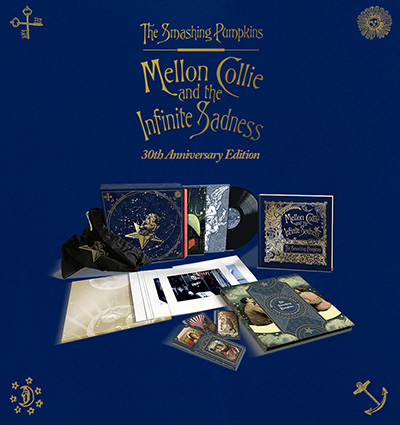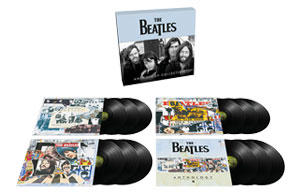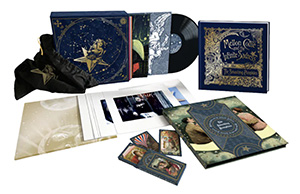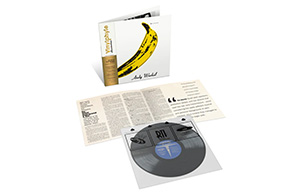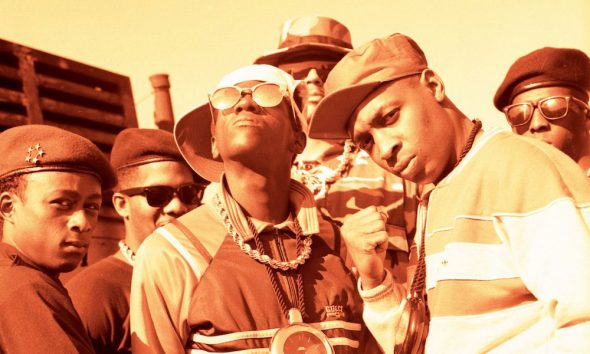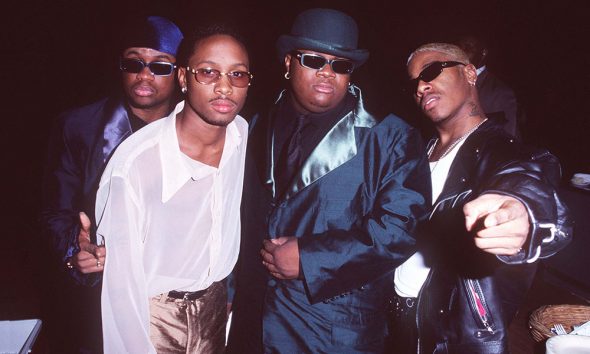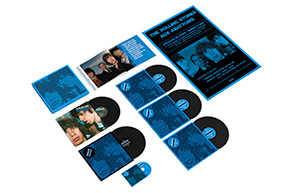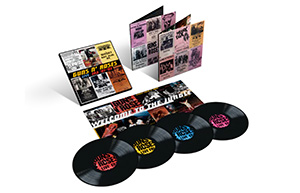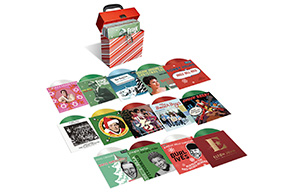The Best Sonic Youth Songs: Alternative Classics
An introduction to the utterly iconic alternative band.

In November 2011, in São Paulo, Brazil, Sonic Youth played their final concert together, just over 30 years after forming in New York City. The intervening years saw them become one of the defining bands of their time, from experimental noise rock beginnings to major label alt.rock stars. The band’s core line-up – Kim Gordon (bass, vocals), Thurston Moore (guitar/vocals), Lee Ranaldo (guitar/vocals) and Steve Shelley (drums) – released a series of albums that changed the perimeters of alternative music while thrilling audiences worldwide with visceral live performances. Such is the consistency and variety of their extensive catalogue, no two Sonic Youth fans would pick the same top 20, but we’ve put together a list designed to act as an introduction to the band – or, if you’re a long-term fan, to remind you of their wild magic. Here are 20 of the best songs from an incredible career.
Buy the best Sonic Youth songs on vinyl and CD now.
20. The Burning Spear (Sonic Youth EP, 1982)
The first song on Sonic Youth’s first release, “The Burning Spear” is a visceral and uncompromising statement of intent – a clanging post-punk howl that features Lee Ranaldo on electric drill and Thurston Moore on prepared guitar (he’d inserted a drumstick beneath the strings on the 12th fret and hammered it with another drumstick). It was a vital song for the band and became a centerpiece of their early live set. In his 2023 autobiography Sonic Life, Thurston Moore writes that a performance at NYC venue Stillwende in December 1981 in which a three-piece line-up of the band (Gordon, Moore and Ranaldo) performed a wild 10-minute version of the song was “the first night that we truly clicked.”
Jamaican music was in the air in early 80s New York. The band’s name was a portmanteau of two acts they admired – MC5 guitarist Fred ‘Sonic’ Smith and Jamaican toaster Big Youth. The repetition and simplicity of Gordon’s four-note bassline takes inspiration from dub (she’d been playing along to Black Uhuru records to learn the instrument), but has a spidery, threatening quality in keeping with NYC post-punk. Meanwhile, Moore’s vocals are an anguished yelp, with “lyrics inspired by the spirit talk heard in reggae music, as well as my religious gleanings.” DIY powertools, dub and spirituality –Sonic Youth were already forging their own unique path.
19. Superstar (1994)
To the members of Sonic Youth growing up in the 70s, Carpenters drummer and singer Karen Carpenter was the wholesome embodiment of middle America. But beneath the surface – as with the Carpenters’ music – was a deep melancholy, and she died of complications from anorexia in February 1983, aged just 32. Kim Gordon was fascinated by Carpenter’s tragic story and wrote the heartbreaking “Tunic (Song For Karen)” for 1990’s Goo, telling the story from the tragic singer’s perspective and focusing on the masculine gaze, eating disorders as a means of establishing control and the trappings of celebrity.
Four years later, with sessions for Dirty coming to an end, Sonic Youth recorded a cover of the 1971 Carpenters hit “Superstar,” originally written by Bonnie Bramlett and Leon Russell, for If I Were A Carpenter, an alt.rock tribute album. Where the Carpenters’ version is lush and dramatic, Sonic Youth take a lo-fi approach (the credit reads, “Not produced, just played”) with layers of distorted guitar and Moore’s mumbled vocals emphasising the pathos at the heart of the song.
18. NYC Ghosts & Flowers (NYC Ghosts & Flowers, 2000)
In 1997, the band began a series of releases on their own SYR label that satisfied their off-kilter and experimental urges. Released in March 1998, the haunting, often-beautiful free improv of SYR3: Invito al ĉielo proved especially significant as it was the first time the group was joined by Chicagoan multi-instrumentalist, composer and producer Jim O’Rourke. The following year, after proving an integral part of SYR4: Goodbye 20th Century – a double-album of interpretations of work by avant-garde composers – Gordon asked O’Rourke to work on the unfinished recordings that would become NYC Ghosts & Flowers. O’Rourke moved into the studio for two months, overdubbing instrumentation and mixing the material (“It was kind of a salvage thing,” he later said).
The album remains among the band’s most challenging and rewarding. It’s a love letter to the New York that nourished them, written at a time when the city was changing fast, with the rapid pace of gentrification pricing out young artists. The title track, written and sung by Ranaldo, summed it up, a free association, spoken-word piece that serves as an elegy to the Beat poets and bohemians who’d made the city their home while evoking another great New York band, The Velvet Underground. From ominous beginnings – a doomy and foreboding bassline, abstract guitar noodles – the song builds into a powerful wall of noise, with Ranaldo asking, “Will we meet?/To run again?/Through New York City ghosts and flowers.”
17. Incinerate (Rather Ripped, 2006)
After five years as a full member of Sonic Youth, Jim O’Rourke left the band in 2005. Pared back to a quartet, Sonic Youth defied expectations once more by making the most immediate and accessible album of their career with 2006’s Rather Ripped. “This record is just a far more straight-up rock and roll album for us,” Moore told CMJ in 2006. “I think the last few albums we’ve done… were much more complex just because there was another musical element into the band. The music [had] sort of a darker, twisted, complex quality to it… I wanted to write songs that were going to be straightforward enough for everybody to plug into immediately.” “Incinerate” was a distillation of this new, clear-cut direction – an indie-rock gem built around an earworm of a guitar riff and given momentum by Steve Shelley’s propulsive drumming.
16. Bull In The Heather (Experimental Jet Set, Trash And No Star, 1994)
Having flirted with the mainstream on 1992’s Dirty, Sonic Youth’s instinct was to return to the underground. Experimental Jet Set, Trash And No Star was the result – a stripped-back, messy and deeply human reaction to the homogenised alternative rock that was shifting serious units post-Nevermind. The album’s brilliantly unsettling lead single “Bull In The Heather” shifted from Gordon’s incantation-like vocals in the verse to a menacing, discordant chorus – hardly the most obvious MTV fodder, but all the better for it. The lyrics were inspired by a bumper sticker sent to Moore and Gordon by Pavement drummer/singer/vibesman Bob Nastanovich that read “I’m betting on the bull in the heather” – a reference to a horse that racing enthusiast Nastanovich was particularly fond of.
15. Death Valley ’69 (Bad Moon Rising, 1985)
“We definitely were a bit fixated on the end of the ’60s,” early Sonic Youth drummer Bob Bert told The Independent in 2020. “With Manson, Altamont and the flower power movement turning dark.” This fascination came to the fore on 1985’s Bad Moon Rising, inspiring a set of songs that form a loose concept album about the dark undercurrent of American culture, the abuse of power and the loss of innocence. It comes to a head on Bad Moon Rising’s climactic track, the Lydia Lunch duet “Death Valley ’69.”
Lunch became a notorious figure on the late ’70s NYC scene at the age of 16, thanks to her controversial performances with her band Teenage Jesus & The Jerks. Though their paths had crossed, she and Moore really hit it off when he played bass on her 1982 solo album, In Limbo. In early 1984, Moore joined Lunch for an impromptu session on Columbia University’s WCKR radio station. During their two-hour bus journey back to Lower East Manhattan, Moore showed Lunch lyrics he was working on inspired by The Family, a book by Ed Sanders about cult leader Charles Manson. Lunch began riffing on Moore’s lyrics and the cathartic and haunting “Death Valley ’69” was born.
14. Unwind (Washing Machine, 1995)
Following the spiky, first-thought-best-thought Experimental Jet Trash…, the band returned to a familiar mode of working. The songs for 1995’s Washing Machine were whittled down from long, exploratory jams in rehearsals, recorded on eight-track and then taken to Easley Studios, Memphis, an old school studio off the beaten track recommended by Pavement (Jeff Buckley, The White Stripes and Cat Power have also recorded at the studio). The band’s previous few albums had proved stressful and fractious, but the casual atmosphere in Memphis worked wonders. “It felt like the old days again,” Ranaldo said in David Browne’s Goodbye 20th Century. Gordon agreed, “This was the beginning of us finding a way to record our music more naturalistically. That record is loose. It sounds like music, and more organic.” “Unwind” is a case in point. A sun-kissed balm following Gordon’s spectacular nine-and-a-half-minute title track, which pivots from snotty, Royal Trux-style punk to glistening krautrock before increasingly intense layers of distortion and white noise bring it home. “Unwind” begins with languid guitar lines in conversation with one another and Moore’s blissed-out vocals, but halfway through the song finds another gear and builds to a distortion-drenched frenzy – you can take the New York punk band out of New York, as they say.
13. The Sprawl (Daydream Nation, 1988)
Daydream Nation is the sound of a band coming of age – an album that took indie-rock to thrilling new places. Years of touring had given them the confidence to stretch out and jam; songs became opportunities to embark upon sonic journeys, all the while maintaining their punk energy. On earlier records, these jams were pared back during writing sessions; on Daydream Nation, the process changed to embrace sprawling, multi-part epics. There was only one thing for it – a double-album.
Gordon’s “The Sprawl” was indicative of this new approach, starting out as a barrage of frenetic riffs and unrelenting drumming before coming apart at the seams and drifting into a lazy and meandering final section, with great swathes of distortion unfurling to mesmeric effect. The title references sci-fi writer William Gibson’s ‘Sprawl trilogy’ of ’80s novels, set in the ‘urban sprawl’ that had developed across the east coast of the United States, while the song’s opening lines are lifted from Pulitzer Prize-nominated novelist Denis Johnson’s 1986 novel The Stars At Noon. Typically, these references are balanced by advertising slogans (Gordon’s chorus “Come on down to the store” was the tagline for NYC department store Bloomingdale’s’ TV ads in the ’80s) and snatches of overheard conversations on the streets of New York.
12. Schizophrenia (Sister, 1987)
“The songs on Sister were mostly in the three- to four-minute range: lean, succinct, more focused than anything we had created prior,” Moore wrote in Sonic Life. Opening track “Schizophrenia” was certainly among their most melodic work to date, all jangling indie-rock guitars and Moore’s dazed vocals. But after a single verse, the tempo shifts and Gordon delivers detached-sounding vocals while chugging guitars ramp up the tension. Eventually, the dam breaks and shards of guitar send the song skyward, providing a sense of release.
The song alludes to Gordon’s experiences with her older brother Keller, who was diagnosed with paranoid schizophrenia. And again, the lyrics took inspiration from literature. “Phillip K Dick understood and wrote about the schizophrenic experience better than anybody,” Moore told Spin in 1989. “He’s definitely important on Sister. The lyrics to ‘Schizophrenia’ and ‘Stereo Sanctity’ were really taken from, like, Radio Free Albemuth.”
11. I Love You Golden Blue (Sonic Nurse, 2004)
Sonic Nurse, the band’s second and final album with Jim O’Rourke in the full line-up, saw Kim Gordon take center stage, contributing the taut post-punk gem “Pattern Recognition,” the raging garage rock of “Kim Gordon And The Arthur Doyle Hand Cream” and the seductive groove of “Dude Ranch Nurse.” Gordon’s hot streak continued with the hypnotic “I Love You Golden Blue,” a song of heartbreaking, hushed beauty that emerges from two minutes of shimmering ambient noise.
Though the target of the lyrics remains ambiguous, Gordon wrote in her 2015 memoir Girl In A Band, “It’s a song about someone who believes he can’t show himself to the world. Believing he’ll only destroy the people he cares about, he avoids all intimacy. He’s stuck. I couldn’t help thinking that was true about a lot of boy-men I’d known in my life.”
10. Sunday (A Thousand Leaves, 1998)
The soundtrack of Richard Linklater’s 1996 movie SubUrbia, an adaptation of Eric Bogosian’s play, was a who’s who of alt.rock, featuring an Elastica and Stephen Malkmus collaboration (on a cover of X’s “The Unheard Music”), Beck, and Butthole Surfers among other indie heroes. Sonic Youth contributed Gordon’s ice-cool shuffle “Bee-Bee’s Song,” the percussive jam “Tabla In Suburbia” and an early version of “Sunday,” which would go on to be the only single taken from their next album, the underrated A Thousand Leaves. The two versions emphasise the shift in the band’s approach as the ’90s drew to a close. The SubUrbia take is loose in comparison to the slacker indie perfection of the version released on the airy and bucolic A Thousand Leaves, not to mention twice as long. “Sunday” drew further attention when released as a single, thanks to Kids and Gummo director Harmony Korine’s provocative video, starring former child stars Macaulay Culkin and Rachel Milner.
9. Kool Thing (Goo, 1990)
Sonic Youth had come of age alongside New York hip-hop with a deep appreciation of the music. Daydream Nation was recorded at the city’s Greene Studios – where formative hip-hop classics by Kurtis Blow and Run DMC were recorded – with engineer Nick Sansano, whom the band chose on the strength of his work with Public Enemy. Kim Gordon was a fan of LL Cool J, but when the pair met for a 1989 Spin interview, she was disappointed to discover that the rapper’s taste in rock music tended towards the mainstream (he namechecked Bon Jovi) and his out-of-date, misogynistic views. Gordon poured her wrath into “Kool Thing,” which namechecked LL Cool J lyrics while asking pointed questions of women’s place in hip-hop (“Are you gonna liberate us girls from male white corporate oppression?”). Public Enemy’s Chuck D was called upon to provide a counter to Gordon’s vocal on the recording, adding appropriately cool asides. The rowdy burst of punk energy was released as the first single from Goo, their major label debut, and became one of their biggest hits, reaching No 7 on the US Alternative Airplay chart.
8. Sugar Kane (Dirty, 1992)
In late 1991, as Nirvana’s Nevermind exploded in popularity around the world, Sonic Youth called on that album’s producer, Butch Vig, to work on their upcoming seventh album, Dirty. When band and producer met in New York, Moore pulled out his copy of Acceptance, an obscure 1983 hardcore EP by Madison band Mecht Mensch, which Vig had produced. Vig was shocked that Moore knew about it and even more so when the guitarist asked that the next Sonic Youth album sound like it. Vig did manage to instil some professionalism in the band, as Moore points out in Sonic Life: “Unlike any of our previous producers, Butch was adamant about our guitars being in tune with themselves, at the very least.”
While Sonic Youth were never likely to threaten Nirvana in terms of sales, songs such as the irresistible “Sugar Kane” were the closest they came to making radio-friendly rock anthems. Even so, they couldn’t resist inserting a fantastically chaotic mid-section, as if to remind the listener of their noise-rock credentials. The song namechecks Marilyn Monroe’s character (Sugar Kane Kowalczyk) from the 1959 film Some like It Hot and, once again, focuses on tragic public figures, according to the sleevenotes of their 2008 compilation, Hits Are For Squares, “The song is inspired by the notion of emotional contact we feel for celebrities on the edge and our desire to ‘save’ them.”
7. Mote (Goo, 1990)
One of Lee Ranaldo’s greatest moments, “Mote” is the dark and sludgy heart of Goo. From disorientating beginnings – an audio collage made from cutting up tapes and splicing them together formed an introduction – it takes off, becoming a tough and propulsive punk blast that eventually collapses, as if utterly exhausted, into a simmering and squalling mess of feedback. Ranaldo took lyrical inspiration from another doomed icon, poet Sylvia Plath, and her poem “The Eye-Mote,” an exploration of morality and perceptions of reality. Fittingly, a demo version of the song, included on the 2005 deluxe edition of Goo and featuring a deadpan Ranaldo vocal, was called “Bookstore.”
6. Youth Against Fascism (Dirty, 1992)
Though Dirty was considered their chance of a mainstream breakthrough, the band didn’t hold back in terms of socially conscious lyrics. Gordon’s “Swimsuit Issue” took a shot at the misogyny of the music industry, while “Shoot” highlighted the plight of a prostitute abused by her pimp. Meanwhile, Moore’s politics were in plainer view than ever, with “Chapel Hill” (an elegy for Bob Sheldon, owner of the activist Internationalist Books and community center, whose murder remains unsolved) and the incensed diatribe “Youth Against Fascism.” Over a gnarly bass riff and thumping drums, Moore takes aim at the Ku Klux Klan, “fascist twerps” and then-president George H Bush. It was given extra clout when Ian MacKaye of fiercely DIY hardcore heroes Fugazi added an improvised guitar part in the studio. “We’re banging pots and pans to make you understand/We’re gonna bury you man,” snarls Moore – unsurprisingly, radio and TV found his bratty rhetoric a hard sell and it flopped as a single, though its righteous ire shines brighter than ever today.
5. Rain On Tin (Murray Street, 2002)
Sessions for the first album to be recorded by the band with Jim O’Rourke as a full member were brought to a halt following the September 11 attacks. By this point, Moore and Gordon were living in Northampton, Massachusetts, and their home provided a refuge for New Yorkers in the weeks after the attacks. Moore wrote a new lyric for a work-in-progress song named “Celtic Frost” after the Swiss heavy metal band, which reflected the events: “Gather round/Gather friends/Never fear/Never again.” The sleevenotes to Hits Are For Squares read, “‘Rain On Tin’ was written as a prayer and cry for love and unity after the destruction of September 11, 2001, in New York City that was shared by gentle folk the world over.” Moore’s open-hearted and defiant lyrics accompanied a truly transcendent piece of music, calling to mind the entwined guitar of Television and the Grateful Dead as it grew in intensity. “Rain On Tin” was debuted at a benefit concert organized by the band for Central American workers killed in the attacks, providing a moment of consolation in a time of need.
4. Theresa’s Sound World (Dirty, 1992)
A masterclass in tension and release, “Theresa’s Sound World” begins with psychedelic guitars circling Thurston Moore’s obtuse, trippy lyrics, which seem to allude to St Theresa of Avila, a well-known Spanish mystic. As the tension grows, Moore and Ranaldo’s guitars become twin cyclones of sound, demonstrating the sheer sonic power at the band’s disposal. In Alec Foege’s Confusion is Next, Butch Vig says it is his favourite track on Dirty: “There was this calm in the studio, the lights were down real low, it was late at night. They’d done several takes on it, and all of a sudden they did that one and the hair on the back of my neck stood up.”
3. Expressway To Yr Skull (Evol, 1986)
Though early drummers Richard Edson and Bob Bert played a vital part in Sonic Youth’s evolution, Steve Shelly joining the band in spring 1985 was the final piece of the puzzle. “It was obvious from day one that our sonic engine had been recalibrated,” Thurston Moore wrote in Sonic Life. “All rockets were set to launch, new planets on the horizon.” Moore had the material to match – on Shelley’s first rehearsal with the band the guitarist introduced them to his strongest song yet, the glorious “Expressway To Yr Skull.”
Though the song soon became a cue for the band to unleash a beautiful barrage of noise – both on 1986’s Evol and as a set closer – it was originally quiet and delicate, with more of an emphasis on melody than Moore’s previous work. “I remember it being a favourite and also being somewhat surprised at the style of the chording,” Shelley told Uncut in 2024. “It was more of a ’60s tune than a punk thing, but yeah, the ’60s was one of my fortes. So I was really pleased to be working on the material and that it was already going this direction.” As the song evolved, the combination of its blissed-out melody, menacing lyrics and exhilarating noise made it one of their most enduring songs. Don’t believe us? Ask Neil Young: “It’s obvious that I like Sonic Youth,” Young told French magazine Guitaire Et Claviers in April 1992. “They make magnificent music. You know that one, ‘Expressway to Yr Skull?’ It’s incredibly good, so beautiful. It’s a classic. Superb melody, and even better live.”
2. Teen Age Riot (Daydream Nation, 1988)
For the latter half of summer 1986’s Evol American Tour, Sonic Youth were supported by Amherst power-trio Dinosaur, led by the enigmatic guitarist J Mascis. Moore was blown away by the sound that Mascis summoned from his defiantly old-school Marshall stacks, a visceral roar with the bludgeoning power of Black Sabbath and the energy of punk. Despite the noise he presided over, Mascis was an unlikely frontman – introverted and quiet. In the summer of 1988 Moore was working on a new piece of music that aimed to “locate the essence” of Mascis and Neil Young’s sound.
At this point, interest in that November’s presidential election was on the rise and Moore had a daydream – what if J Mascis ran for office? In the Daydream Nation deluxe edition sleevenotes, Moore confirmed, “It was actually about appointing J Mascis as our de facto alternative dream president.” The opening track on Daydream Nation, after a woozy, dream-like intro, “Teen Age Riot” bursts into life – an intoxicating and ageless anthem to the lifesaving power of rock’n’roll. Moore alludes to political unrest in the air (“Everybody’s talking ’bout the stormy weather”) before suggesting a new kind of leader. Though his lyric doesn’t explicitly mention Mascis, its call for a man, “with Marshall stacks to at least just give us a clue” is a clear nod. “Teen Age Riot” became one of Sonic Youth’s most beloved songs.
1. The Diamond Sea (Washing Machine, 1995)
At a point where some bands might’ve looked for hits, Sonic Youth went even further out – with transcendent results. The closing track on Washing Machine starts out as a chugging, bittersweet ballad before embarking upon a skyscraping symphony of distortion. “With ‘The Diamond Sea,’ we really got back to what we really did, which was noisy sound experiments,” Lee Ranaldo said in Goodbye 20th Century, “We were starting to flex those muscles again.” It’s their longest track – the album version is nearly 20 minutes, a take released on B-sides collection The Destroyed Room is around 26 minutes long – but time behaves differently during “The Diamond Sea” as waves of crystalline distortion ebb and flow, flitting between moments of serene beauty and crushing intensity. “The Diamond Sea” is a summation of everything that made Sonic Youth special.

